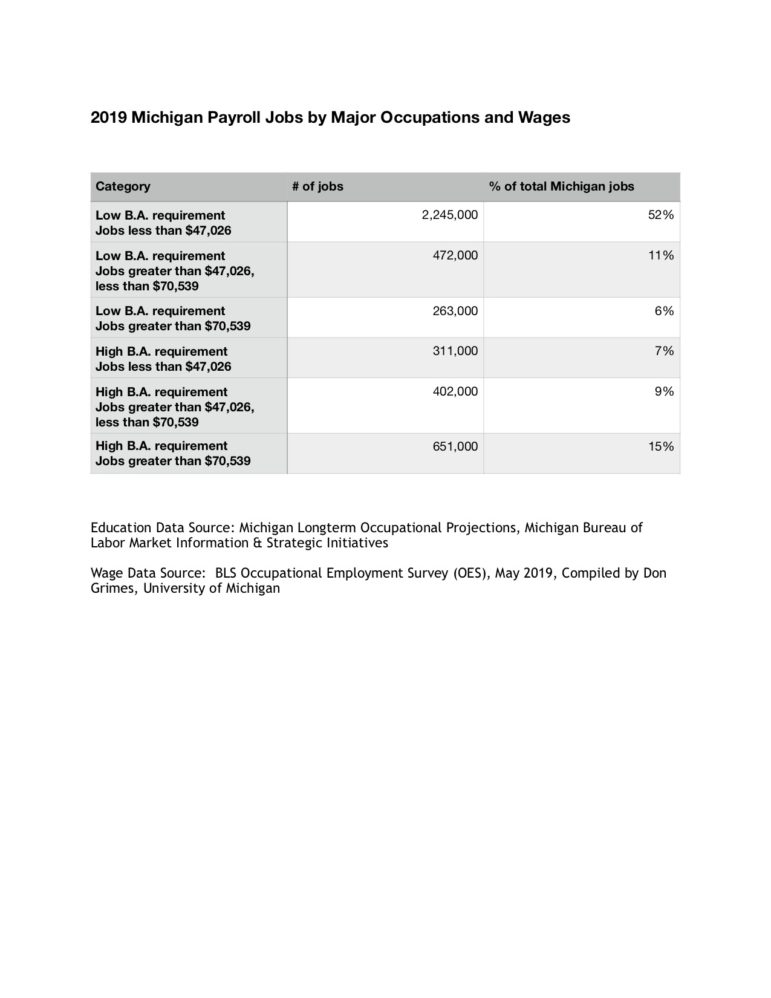
Michigan’s two-tier economy exists in large part because Michigan has a two-tier labor market. Michigan’s high ALICE rate––38 percent in the strong 2019 economy––exists in large part because Michigan has a two-tier labor market.
The reality is that in both expanding and contracting economies, Michigan has two labor markets: one tier of occupations that do not require a B.A. where a preponderance of jobs pay below what it takes to be middle class; and a second tier for occupations that require a B.A. where the preponderance of jobs pay more than what is required to be middle class.
To make matters worse, employment in the low B.A. requirement occupations far out number employment in the high B.A. requirement occupations. In 2019, 2.98 million Michigan payroll jobs were in the low B.A. requirement occupations compared to 1.36 million in the high BA requirement occupations.
In a new analysis for Michigan Future by the University of Michigan’s Don Grimes we divided the labor market into payroll jobs that pay below what it takes to be middle class for a family of three; payroll jobs that pay enough to be lower middle class for a family of three ($47,026); and payroll jobs that pay enough to be upper middle class for a family of three ($70,539).
The table at the end of this post depicts Michigan’s two-tier labor market.
The table portrays a labor market where more than one half (52 percent) of all Michigan payroll jobs are in low B.A. required occupations that pay below what it takes to be middle class; 11 percent are in low B.A. required occupations that pay enough to get into the lower middle class; and six percent are in low B.A. required occupations that pay what it takes to be upper middle class.
By contrast, seven percent of all Michigan payroll jobs are in high B.A. required occupations that pay below what it takes to be middle class; nine percent are in high B.A. required occupations that pay enough to get into the lower middle class; and 15 percent are in high B.A. required occupations that pay what it takes to be upper middle class.
Maybe the most important lesson we need to learn about Michigan’s two-tier labor market is that you cannot educate your way out of too many workers in below middle class paying jobs. Only 17 percent of all payroll jobs in the strong 2019 Michigan economy are in occupations that do not require a B.A. and pay more that $47,026. Around 70 percent of working age Michiganders do not have a four-year degree. So the stark reality is that––no matter how strong the economy––there are way too few up-the-ladder jobs for those without a B.A. no matter what their level of education attainment.
What these data make clear is that if we are serious about achieving an economy that as it grows benefits all Michiganders we need to figure out how to increase income and benefits of lower-wage workers. If we don’t figure out how to do that we are going to have a permanent two-tier economy anchored by a two-tier labor market.
(For those of you interested in more detail, the low B.A. required major occupations are: Building and Grounds Cleaning and Maintenance; Construction and Extraction; Farming, Fishing, and Forestry; Food Preparation and Serving Related; Healthcare Support; Installation, Maintenance, and Repair; Office and Administrative Support; Personal Care and Service; Production; Protective Service; Sales and Related; and Transportation and Material Moving; .
The high B.A. required major occupations are: Architecture and Engineering; Arts, Design, Entertainment, Sports, and Media; Business and Financial Operations; Community and Social Service; Computer and Mathematical; Educational Instruction and Library; Healthcare Practitioners and Technical; Legal; Life, Physical, and Social Science; and Management.)








